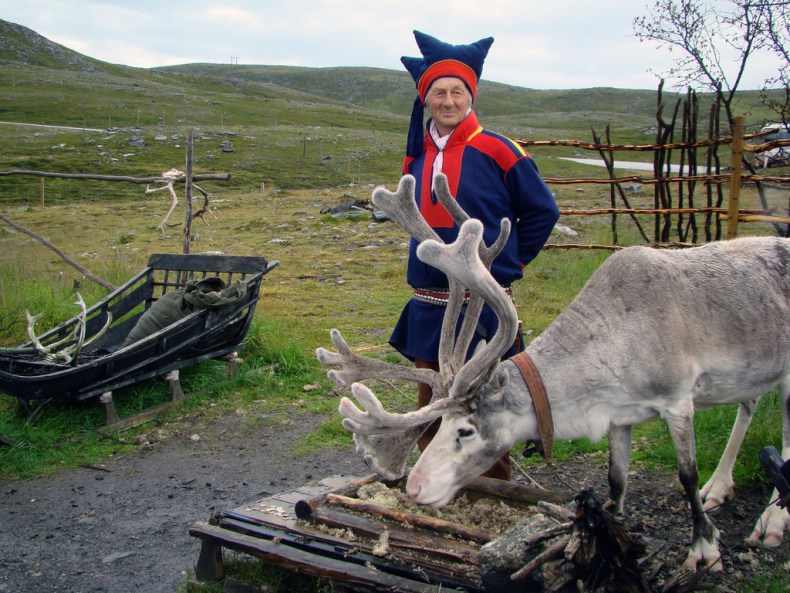
by Deep Green Resistance News Service | Mar 29, 2016 | Biodiversity & Habitat Destruction, Indigenous Autonomy
Sámi representatives call for swift support from the international community
Featured image: Sámi and reindeer. Photo by Dutchbaby @flickr (some rights reserved).
An unprecedented land grab will threaten the last old growth forests of Finnish Lapland and the homeland of the indigenous Sámi Peoples if a new Forestry Act is approved by the Finnish Parliament this week. 130,000 people have already petitioned the parliament to stop the Forestry Act, which Sámi indigenous groups say would lead to the end of Sámi reindeer herding in its current form.
A State-driven land grab
This crisis arrives in a context in which the previous Finnish Government failed to ratify the UN Convention on the Rights of Indigenous Peoples, leaving the Sámi vulnerable. Now the current government in Finland is moving fast to completely wreck the existing rights of the only Indigenous Peoples living in the European Union. If the new Forestry Act is passed, Sámi areas in Upper Lapland, including large tracts of boreal old growth forests, will be opened up to a range of economic uses.
The new Act would affect 2.2 million hectares of water systems and 360,000 hectares of land, mostly in the Sub-Arctic and North Boreal areas of Finland, the Sámi’s Home Area. This area constitutes the last preserved wilderness of Europe. The Act would transfer power over this region further into the hands of state authorities, opening up the Sámi Home Area and sub-Arctic ecosystems to railway construction, and with that, potential expansion of mining, forestry and other infrastructure projects.
The new Forestry Act would no longer require Metsähallitus, the Finnish state-run enterprise which already controls 90% of the Sámi Home Area, to liase with the Sámi Parliament and the Skolt Sámi Village Council on issues of land management and their potential impacts on indigenous people’s lives. The preparation of this Act has not been conducted with the Free, Prior and Informed Consent of the Sámi People.
Sámi Culture Under Threat
There is an urgent need to ensure that Metsähallitus and others are prevented from undermining present or future opportunities for the Sámi to practice and foster their culture. The new Act needs to include clauses that provide a protective zone and mechanisms for the Sámi to safeguard their cultural practices. These are missing from the existing legal proposal leaving both Indigenous Sámi leaders and Arctic scientists concerned about the proposed new reforms.
“Sámi reindeer herding and the Sámi way of life are in danger of disappearing if the new Forestry Act legislation passes in the Finnish Parliament. In this case we will have few opportunities to influence the decision making over our lands. Rather, our territories will be controlled by market economy values,” says Jouni Lukkari, President of the Finnish Section of the Sámi Council.
Tero Mustonen, a scientist from the Snowchange Cooperative, and one of the Lead Authors of the Arctic Council’s Arctic Biodiversity Assessment (ABA), adds: “Arctic peoples have thrived in a harsh environment for millennia, in no small part because they have acquired a great depth of knowledge about the land and waters of their homelands and the species that live there, which provide food, clothing and meaning to Arctic cultures. This traditional ecological knowledge is increasingly recognized as an important source of information for, among other things, understanding Arctic biodiversity and developing effective strategies to conserve that biodiversity, including indigenous ways of life.”
Furthermore, Mustonen says that “In this period of rapid climate change in the Arctic it is imperative that these northern ecosystems are preserved intact – they are central to the Indigenous peoples’ survival and a source of their knowledge in this new reality. The Forestry Act in its current form would cause severe negative impacts to Sámi society as we know it.”
Concerned about the threat to their culture and homelands, all of the Sámi reindeer herding cooperatives, the economic units through which reindeer herding is organized in Finland, are opposing the new Act. Despite decades of industrial forestry and road construction in Southern and Middle Lapland, the Sámi’s traditional trade has been able to cope and maintain its iconic socio-ecological complex. But the new Act threatens to change all of this.
Since details of the new Forestry Act emerged, the reindeer herding cooperatives, as well as the national Sámi Parliament and the international Sámi Council, have taken strongly-worded letters to Finland’s Prime Minister Juha Sipilä asking him to stop the Act in its current form.
The Act must be stopped
Considering both the historical damage they have sustained and the difficulties of adapting to rapidly-proceeding Arctic climate change, Sámi reindeer herding practices cannot cope with the imposition of the sudden industrial changes promised under the new Forestry Act, Mustonen explains. “There is an urgent need to stop the current form of the Forestry Act from proceeding further”.
Should the Act manage to pass in the Finnish Parliament this week, the Sámi will demand a full Moratorium on all state forestry and infrastructure actions inside the Sámi Home Area until such a time that the Indigenous rights over the area can be jointly agreed on.
Mustonen also suggests that a mapping of the Sámi Land Use, in accordance with international standards, should be enacted to document the historical and contemporary land and water rights of the Sámi. “This could then serve as a basis of a neutral re-start to Sámi – State relations in Finland; a re-start much needed and awaited by all parties,” he concludes.
In the meantime, Sámi representatives are requesting support from the international community.
For further information, contactTero Mustonen, Ph D Snowchange Cooperative HAvukkavaarantie 29FIN 81235 Lehtoi Finland
tero@snowchange.org +358 407372424
by Deep Green Resistance News Service | Mar 20, 2016 | Indigenous Autonomy
On Monday, February 29, nearly two months after armed militants took over the Malheur National Wildlife Refuge, the Burns Paiute Tribe was finally allowed to visit it. The refuge is their ancient wintering grounds and filled with culturally-sensitive sites and even burial grounds of their ancestors. On Thursday, 14 more militia members were arrested, including two more members of the Bundy family who led the armed standoffs in Oregon and Nevada against federal authorities.
“I’m glad they cleaned up all those urinals they made,” Burns Paiute tribal councilman Jarvis Kennedy told ICTMN. “They went in with Hazmat suits on and got all of that out of there and covered it up. When I first saw it kind of made me mad. That’s our burial ground area.”
RELATED: ‘It’s So Disgusting’ Malheur Militia Dug Latrine Trenches Among Sacred Artifacts
The 178,000-acre refuge was once part of the Malheur Indian Reservation that was the homeland of Northern Paiute tribes like Wadatika, the name Burns Paiute people called themselves after small seeds they harvested along Malheur and Harney Lakes.
Kennedy said he couldn’t get into specific details as to how the federal authorities are going to proceed with cleanup. The painful process will proceed to remove a road the occupiers constructed, as well as three different trenches they dug where they dumped trash and human feces. The FBI had reported last month that one of these trenches was close to culturally-sensitive sites on the refuge. The tribe received a plan from the archaeologist for assessment of damage and loss of cultural artifacts and sites.
“I think they got a case against them,” Kennedy told ICTMN. “[The militants] were dumb enough to make a video of themselves making the road and digging. They also left fingerprints on the controls of the heavy equipment they operated.”
On Wednesday, the Burns Paiute Tribal council met with Bureau of Indian Affairs regional director, Stanley Speaks in Portland. He assured them that the BIA would offer assistance for expenses the tribe had incurred for extra law enforcement patrols and for the aftermath. The tribe provided full 24-hour police coverage for their community during the 41-day occupation of the refuge.
“The Chief of Police of Warm Springs Reservation sent us two officers to help us, then two more,” Kennedy explained. “They were each on a five-day shift.”
While in Portland, the tribal leaders also met with the U.S. Attorney General Loretta Lynch who thanked the tribe for all their support during the occupation. She also thanked the people of Burns and Harney County “who had to endure an occupation of their town.”
Tribal members and townspeople faced harassment and threats from the armed occupiers who invaded their community. Native men were a particular target in town. Tribal leaders, local law enforcement and Fish and Wildlife employees all reported out-of-state vehicles driving slowly by their homes at night and had their families threatened. Fish and Wildlife staff were all sent away during the occupation for their safety and have only just returned.
Kennedy says there is still a lot of animosity, especially from businesses in the town of Burns that were backing the occupation. The local Verizon franchise owner had her truck plastered with stickers supporting the militants. She took the stickers off after the Verizon corporate office demanded she do so, but tribal members are still boycotting her business.
Another local business owner, an optometrist, who was an outspoken supporter of Bundy and his followers has also lost tribal business. The tribe is “hurting them in the wallet,” Kennedy says.
However, the occupation also brought out their supporters in the community and the tribe discovered they had many allies they could count on when it really mattered.
“It’s good to have allies on our side,” says Kennedy. “We have to work with the town. We are a sovereign nation and we believe in having a good neighbor policy.”
On Thursday, the FBI arrested 14 more militants, including two more Bundy brothers, who join their father Cliven Bundy and brothers Ammon and Ryan Bundy in jail. Also arrested was Jerry DeLemus, a co-chair of New Hampshire’s committee to elect Trump, the Republican presidential frontrunner.
All 14 were charged with armed assault against federal law enforcement officers during the 2014 standoff in Nevada when an armed group of supporters of Cliven Bundy successfully forced the Bureau of Land Management to stop removal of Cliven’s cattle from federal land. The rancher had over copy million in unpaid grazing fees to the federal government.
Also on Thursday, Ammon Bundy the leader of the takeover at Malheur, released a video from jail in Portland, Oregon. He says he’s not ashamed and doesn’t regret what he did because he knew “it was right.”
Since his arrest, Ammon has tried to recast the armed occupation as an act of free speech and played down the guns he and his followers brandished. In interviews and on social media the militants claimed they were willing to die to return federal land to “the original owners”—ranchers, miners and loggers. In his recent video, he termed the 41-day takeover “a demonstration.” Malheur and the BLM grazing land the Bundys use in Nevada are both unceded territories belonging to the Paiute and Shoshone peoples.
“They are in jail,” Councilman Kennedy said about Ammon and his followers, “It’s like we said at our first press conference when this all started. We were here first before they came here and we are going to be here after they are all gone. They are all gone and we now have to deal with that mess.”
Meanwhile back at the refuge, tundra and trumpeter swans, northern pintails, red-winged blackbirds, and sandhill cranes have all been seen. Over 320 species call the refuge home either for short stopovers as they head north or for nesting. Friends of Malheur National Wildlife Refuge Facebook page shared a photo of arriving swans saying, “Normalcy rests on the wings of these birds and is exactly what those of us who live here and everyone that has made Malheur a part of their lives have needed.”
by Deep Green Resistance News Service | Mar 13, 2016 | Toxification
Featured image: A huge proportion of the Nahua tribe have been affected by the poisoning, which causes anemia and acute kidney problems © Johan Wildhagen
By Survival International
Up to 80% of a recently-contacted tribe in Peru have been poisoned with mercury, raising serious concerns for the future of the tribe. One child has already died displaying symptoms consistent with mercury poisoning.
The source of the Nahua tribe’s poisoning remains a mystery, but experts suspect Peru’s massive Camisea gas project, which opened up the tribe’s land in the 1980s, may be to blame. The project has recently been expanded further into the Nahua’s territory, prompting fierce opposition from the tribe.
Rampant illegal gold mining in the region is another potential source of the mercury poisoning.
The Nahua, who live inside a reserve for isolated Indians in south-east Peru, have also been suffering from acute respiratory infections and other health problems since they were contacted.
Other indigenous communities in the area may also have been affected by mercury contamination, but tests have not been carried out. Some of these communities are uncontacted or extremely isolated. It is understood that the Peruvian Health and Environment Ministries have been aware of the problem since 2014.
AIDESEP, the main indigenous organization in Peru’s Amazon, is lobbying the government to carry out full health checks on the Nahua and other tribes in the area, and to conduct a proper investigation into the cause of the poisoning. A study was conducted by the Ministry of Health in spring 2015, but the results have yet to be published.
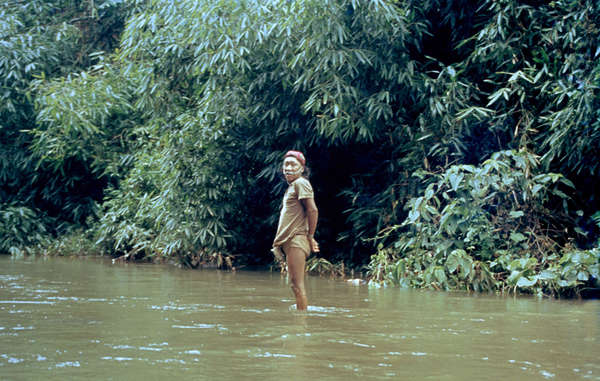
The Nahua were first contacted in the 1980s. Subsequent epidemics killed many members of the tribe
© Survival International
Nery Zapata, an indigenous leader, said: “Mercury contamination is extremely damaging to human health because its effects are irreversible. The health department must investigate this, and stop the contamination that is poisoning the indigenous population.”
Survival has also written to the Peruvian Ministries of Health and Culture urging them to publish the results of their study and put an end to the catastrophe.
Survival’s Director Stephen Corry said: “The Peruvian authorities have always been pretty indifferent to the problems facing their indigenous communities, and the total neglect they’ve shown in this case just proves it. Had this poisoning taken place in Lima, I don’t expect they would have been quite so casual in their response, or as slow to publish the results of their earlier findings. It’s nothing short of scandalous that they are not doing more to sort out this crisis. It’s also very telling that they are withholding information about it from the public.”
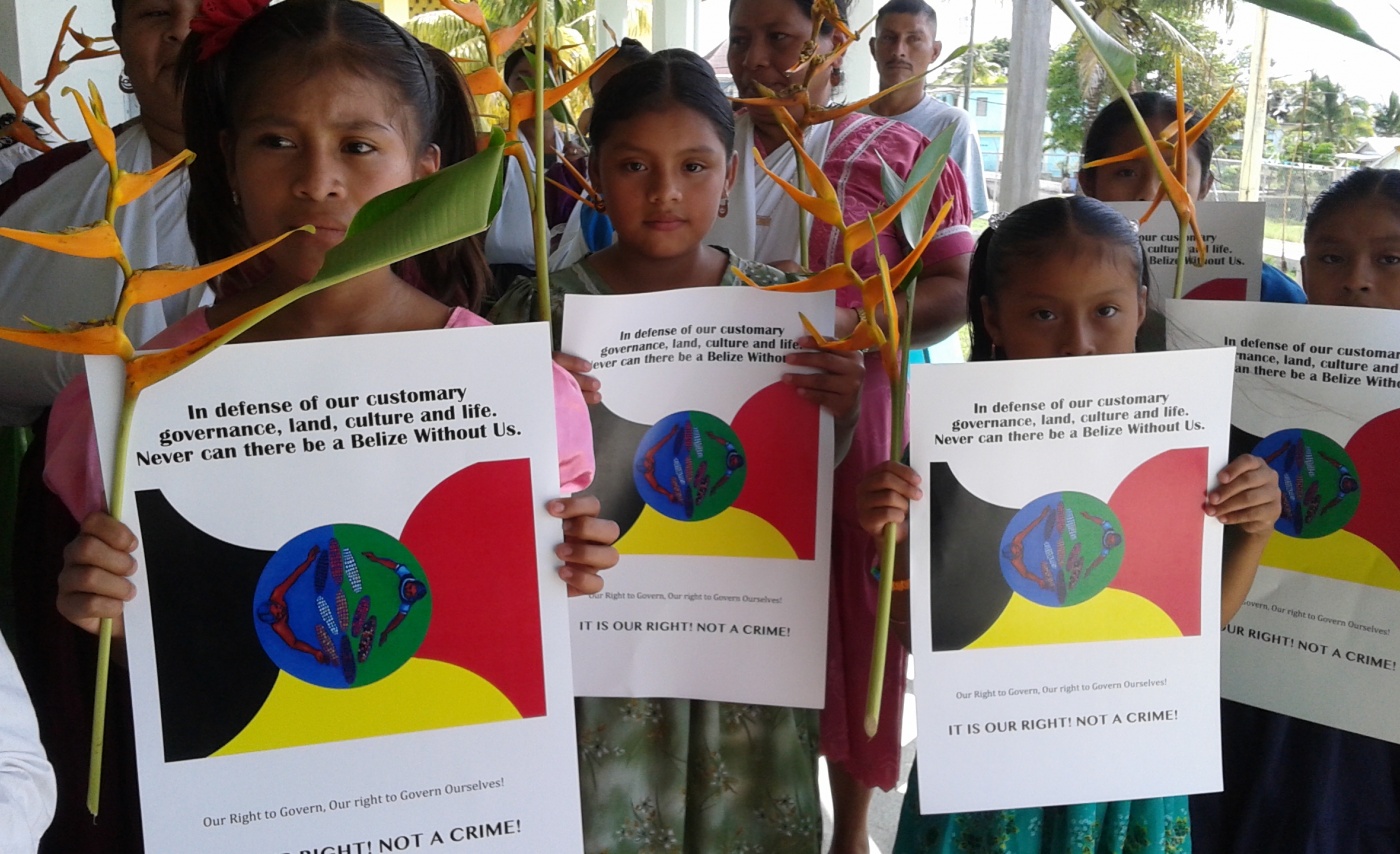
by Deep Green Resistance News Service | Mar 12, 2016 | Indigenous Autonomy
By Cultural Survival
Thirteen Maya villagers will be standing trial in Belize on March 30th, 2016, under fabricated charges. Like many Indigenous leaders fighting to protect their lands, they are being criminalized for these actions, and may face prison time.
On the early morning of June 24th, 2016, traditional leaders of the Maya people of Southern Belize were violently awoken in their homes by police. Charges were brought against 13 people, including 10 farmers, two traditional Maya leaders, and Q’eqchi community spokesperson Cristina Coc, advisor to the traditional leaders and mother of two.
The Maya leaders’ alleged crime relates to the defense of the Uxbenka archaeological site, a sacred site to the Maya people, located within traditional lands titled to the Maya people under national and international laws. The disputed conflict arose after Mr. Rupert Myles, a Belizean citizen, illegally constructing a house on the grounds of the ancient temple against the advise of the community. According to the Maya community members, the Belize authorities failed to respond to their call to stop Mr. Myles from doing further harm to the site. The community explained that Mr. Myles was invited to a community meeting to resolve the conflict where he became unruly and village police detained him. However, Myles later accused the Mayas of physically assaulting him at the community meeting, a claim the Maya leaders strongly deny.
Since 2007, Santa Cruz have legal customary ownership of customary lands, where Uxbenka is located, as result of a decision from the Supreme Court that the government of Belize never contested. To date, the government has not taken an steps to protect the property rights of the Santa Cruz Mayas in accordance with their customary land tenure system.
Recently, the Caribbean Court of Justice handed down a judgement ordering the government of Belize to demarcate and register Maya village lands, and to protect them against incursions by outsiders. ‘’The Santa Cruz conflict and subsequent arrests is a direct assault to the spirit of the court order, and shows bad faith engagement by the government,’’ explained Program Coordinator for the Maya Leaders Alliance, Pablo Mis.
The laws of Belize prohibit building on or damaging any archeological site. In May 2015, a letter was sent to the Belize Institute of Archaeology (NICH) from the Director of the Uxebnka Archaeological Project, in which he expressed his concern that Mr. Myles had: “bulldozed into the archaeological platform (…). He has also built new buildings, and has burned vegetation to the very edge of the steel plaza, further endangering the ruin. The bulldozing activity has irreparably damaged the platform.” However despite this, since the charges were brought, Belizean authorities have continued to allow Myles to maintain construction and ongoing desecration of the archeological site held sacred to the Maya.
The Maya leaders stand by their actions. Indigenous People’s right to defend their sacred sites is backed by the UN Declaration on the Rights of Indigenous Peoples. Article 11.1 states that Indigenous Peoples have the right to protect past manifestations of their cultures, such as archaeological and historical sites. Article 11.2 requires States to provide redress with respect to their cultural property taken without their Free, Prior and Informed consent or in violation of their laws traditions, or customs. “The Maya villagers will continue to defend these cultural heritage sites that are important to all Belizeans,” explained the Maya Leaders Alliance in a press release.
The situation is being closely monitored by international human rights bodies, including the UN Special Rapporteur on the rights of Indigenous Peoples, Ms. Vicky Tauli-Corpuz. “I am concerned by the inaction of the Government of Belize to assist Maya villagers to protect their property rights in the face of threats to those rights,” she expressed in a press release, explaining, “It appears as though the repeated requests to local police by Santa Cruz village leaders for assistance in removing the individual from the archaeological site within their village lands, went ignored.”
Listen to an interview with the Special Rapporteur:
Friends of Santa Cruz 13 are urgently seeking funds to cover legal counsel to defend their 13 community members on March 30th. See their call for donations here.
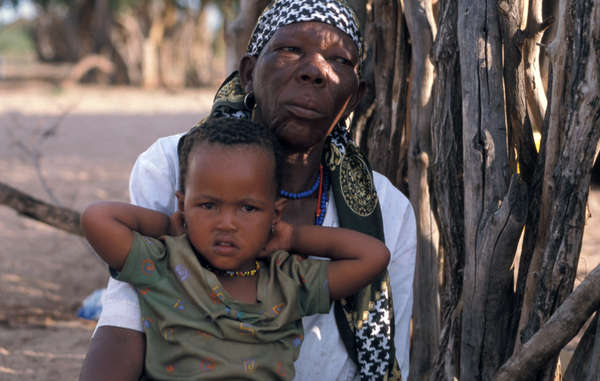
by Deep Green Resistance News Service | Mar 11, 2016 | Colonialism & Conquest
Featured image: Botswana government resettlement camps are poorly supplied, and diseases like HIV/AIDS are rife. © Fiona Watson/Survival International
By Survival International
Survival International has launched a campaign calling for an end to a draconian system in Botswana which has broken Bushmen families apart and denied them access to their land. Critics such as veteran anti-apartheid activist Michael Dingake have compared the system to the apartheid-era pass laws.
The call comes in the fiftieth anniversary year of Botswana’s independence.
After having been brutally evicted and forced into government camps between 1997 and 2002, the Bushmen won a historic court victory in 2006 recognizing their right to live on their land in the Central Kalahari Game Reserve.
Since then, however, this right has only been extended to the small number of Bushmen named in court papers. Their children and close relatives are forced to apply for permits just to visit them, or risk seven years in prison, and children born and brought up in the reserve have to apply for a permit when they turn 18. Many fear that once the current generation has passed away, the Bushmen will be shut out of their land forever.
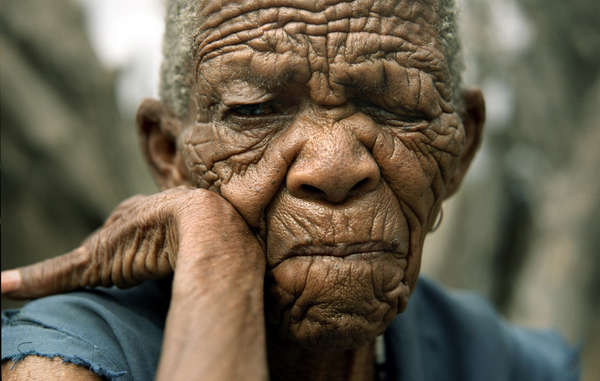
Most Bushmen are still forced to live in government resettlement camps, rather than on their land in the Central Kalahari Game Reserve
© Dominick Tyler
On the subject of the fiftieth anniversary, one Bushman told Survival: “I don’t even know anything about these celebrations. They are doing this so that people will not think they are a bad government. They are celebrating; we are not. We’re still feeling the same way. They’ve been celebrating for the last 49 years.”
Survival’s Director Stephen Corry said: “The Botswana government has viciously persecuted the Bushmen for decades, first with violent evictions and then with a permit system designed to break families apart. If Botswana still wants to be seen as a “shining light” of democracy in Africa, it needs to listen to the Bushmen, uphold its own court’s ruling and end this appallingly unjust restriction on the Bushmen’s right to live on their ancestral land in the Central Kalahari reserve. I hope that this historic year will mark the end of the decades long persecution of the Bushmen.”





